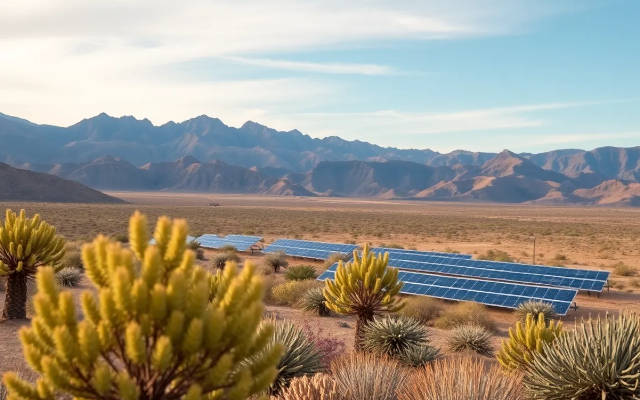Sun vs. Sagebrush: Nevada's Solar Boom Meets Its Wild Heart

Less an 0.03 percent of land set aside for solar development in Nevada is currently producing clean, renewable electricity
By EVWorld.com Si Editorial Team
The Mojave sun doesn't care about politics. It scorches the desert floor with equal intensity whether the land is zoned for wilderness or wired for solar. But in Nevada, where climate urgency meets ecological fragility, the battle over sunlight is anything but neutral.
In 2025, the Bureau of Land Management opened the door to solar development across 12 million acres of Nevada's public lands - an area nearly the size of West Virginia. The goal? Accelerate the clean energy transition. The risk? Bulldozing some of the most intact desert ecosystems left in the American West.
At the center of the fight was the Esmeralda 7 solar proposal, a now-shelved mega-project that would have blanketed 118,000 acres of central Nevada with photovoltaic panels. Conservationists called it "Las Vegas in panels." Developers called it progress. The truth lies somewhere in between.
The Land That Time Forgot
Esmeralda County is a place of extremes: fewer than 800 residents, no traffic lights, and some of the darkest skies in the Lower 48. It's also home to desert bighorn sheep, ancient petroglyphs, and the proposed Esmeralda/Fish Lake Area of Critical Environmental Concern (ACEC) - a designation that would protect wildlife corridors and cultural sites from industrial encroachment.
Friends of Nevada Wilderness, a nonprofit with deep roots in the state?s conservation movement, led the charge against Esmeralda 7. Their argument wasn't anti-solar - it was pro-place. "We support renewable energy," says Executive Director Shaaron Netherton, "but not at the expense of Nevada's wild heritage."
Why the Trump Administration Pulled the Plug
In October 2025, the Trump administration abruptly canceled the environmental review for Esmeralda 7, effectively killing the project. No formal reason was given, but the move fits a broader pattern: federal permitting freezes, regulatory rollbacks, and skepticism toward utility-scale renewable energy on public lands.
Energy analysts point to a - multitude of regulatory barriers and delays - imposed by the administration, which placed financial strain on developers like NextEra and Invenergy. The cancellation wasn't just about wildlife - it was about politics. The project had advanced under the Biden administration, and its scale made it a symbol of federal climate ambition. That made it a target.
Solar's Footprint: Big Ambitions, Small Buildout
Despite the headlines, only about 20,000 acres of Nevada's land currently host solar arrays - less than 0.03% of the state's total area. Most of these projects are clustered near transmission lines and urban centers. But as demand grows, developers are eyeing remote basins and sagebrush flats, where land is cheap and opposition is sparse.
That's where the ecological stakes rise. Solar development can fragment habitat, disrupt migration routes, and alter microclimates. Desert tortoises, kit foxes, and pollinators are especially vulnerable. And while federal guidelines require environmental review, critics say they're often rushed or underfunded.
Mitigation That Works
Not all solar projects are created equal. Conservationists and developers alike are pushing for smarter siting and better design. Here's what's working:
- Elevated panels: Allow wildlife to pass underneath and reduce ground disturbance.
- Vegetation buffers: Preserve native plants and reduce erosion.
- Wildlife corridors: Maintain connectivity between habitats, especially for large mammals.
- Community consultation: Engage local tribes and residents early to avoid cultural conflicts.
- Brownfield prioritization: Build on degraded or previously developed land instead of pristine wilderness.
Some developers are listening. Others are not. The challenge is scale: how to build thousands of megawatts of clean energy without sacrificing the very landscapes that make Nevada unique.
A Path Forward
The cancellation of Esmeralda 7 was a win for wilderness, but the solar debate is far from over. With climate deadlines looming and federal incentives flowing, Nevada will remain a battleground for land use, energy policy, and ecological integrity.
Friends of Nevada Wilderness isn?t trying to stop the sun. They?re trying to shape its shadow. And in a state where wildness is both a resource and a refuge, that might be the most radical act of all.
Sources
- MSN - Trump Administration Cancels Esmeralda 7
- Politico - Interior Cancels Largest Solar Project
- Heatmap ? Esmeralda 7 Cancellation
- BLM - Libra Solar Project Final EIS
- REWI - Solar Energy Wildlife Interactions
Original Backlink
Views: 142
Articles featured here are generated by supervised Synthetic Intelligence (AKA "Artificial Intelligence").
